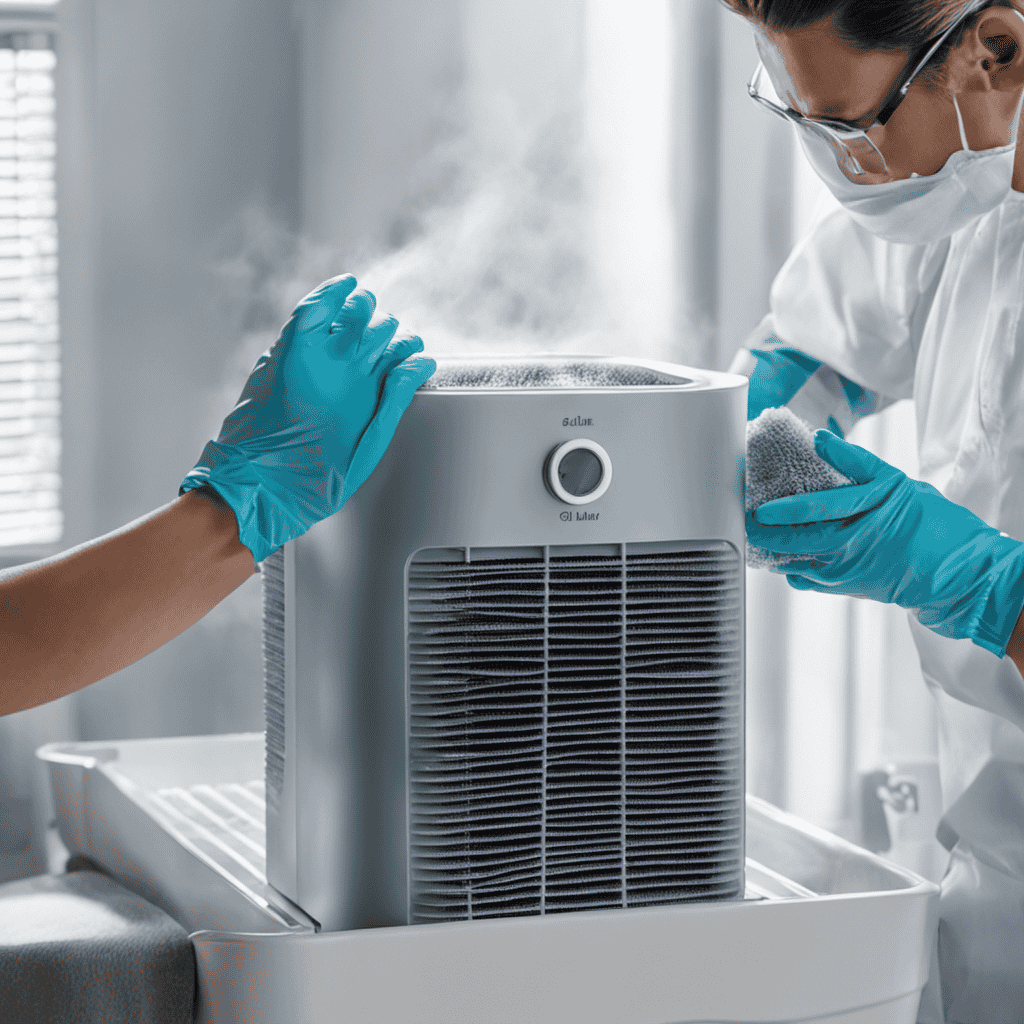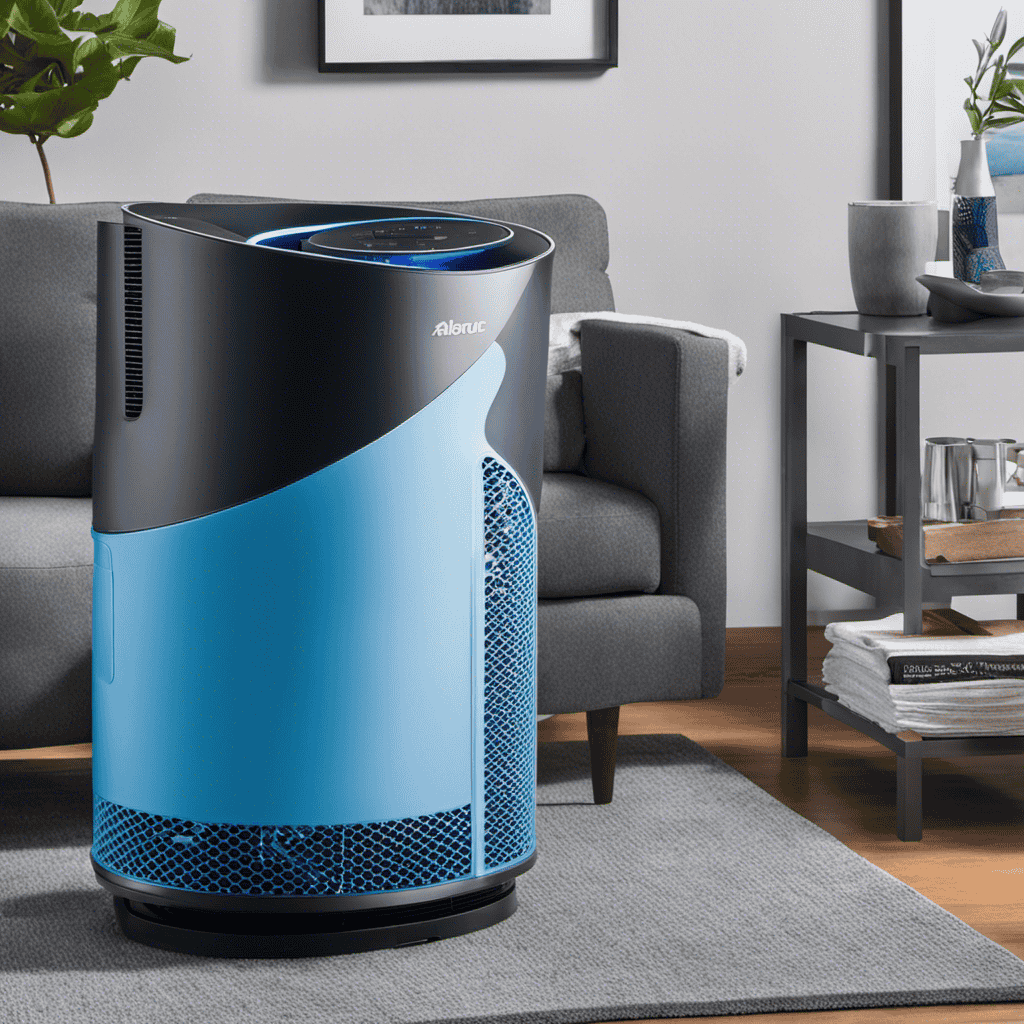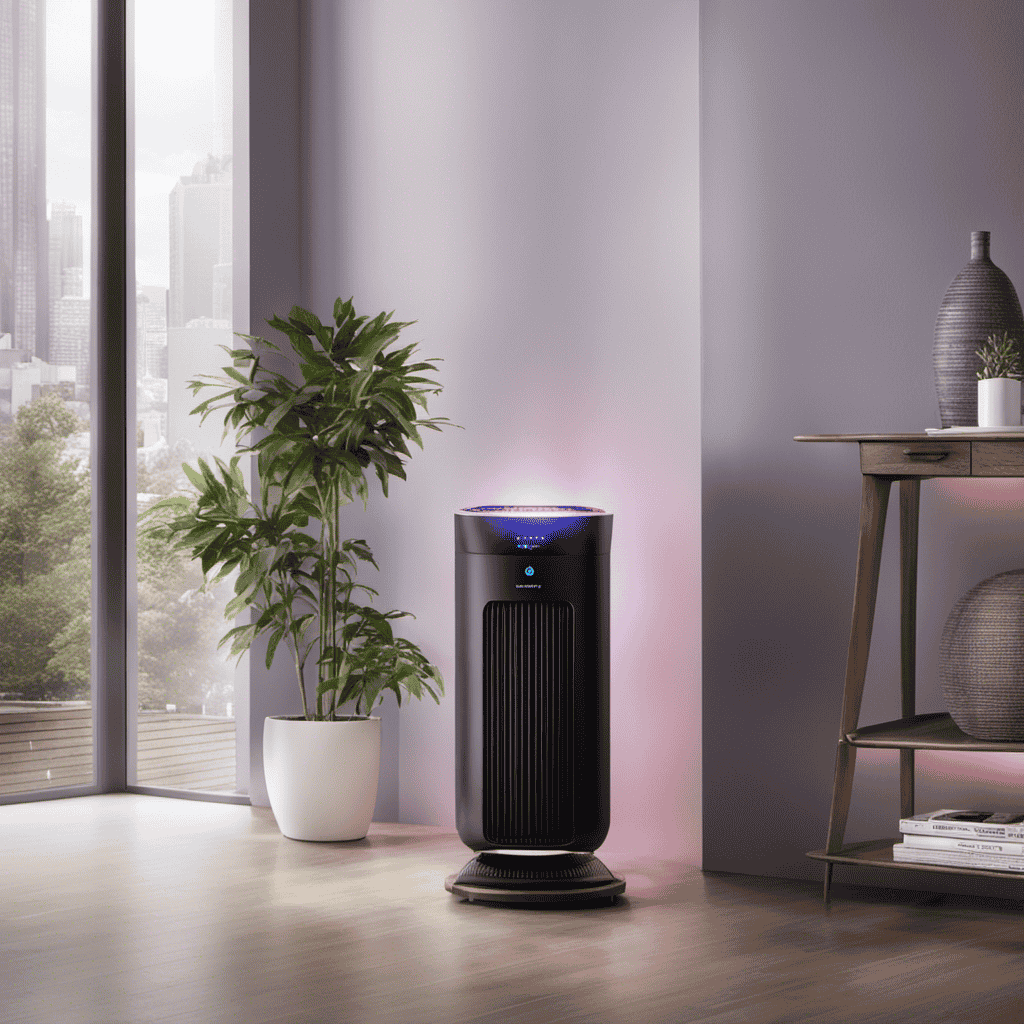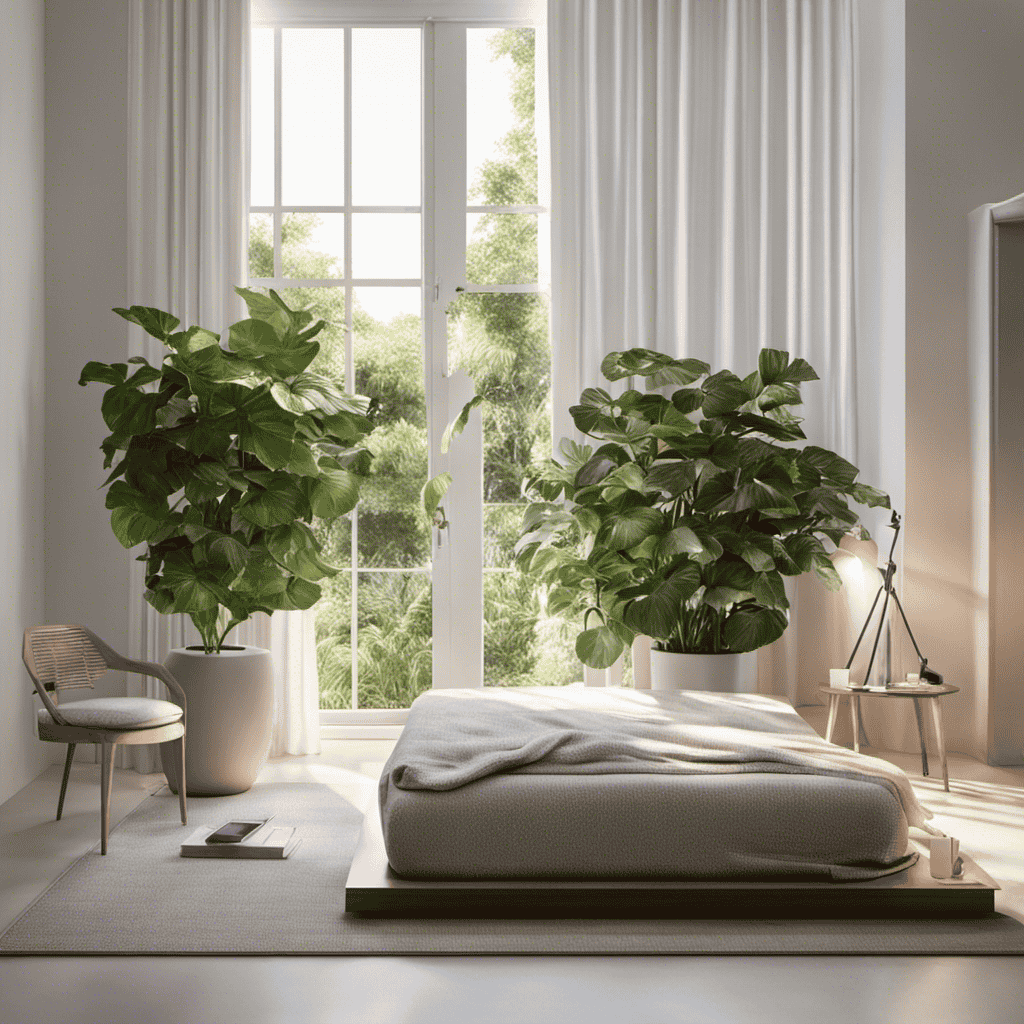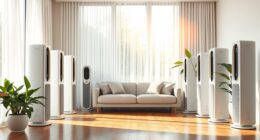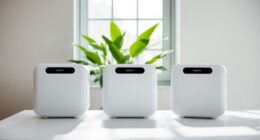I understand that cleaning air purifier filters may seem like a bother, but believe me, it is worth it. In this article, I will help you with a detailed guide on how to clean your blue air purifier filter step by step to maintain its peak performance.
By understanding the importance of regular maintenance and using the proper cleaning method, you can breathe cleaner air and extend the lifespan of your filter.
So, let’s dive in and learn how to keep your blue air purifier filter squeaky clean.
Key Takeaways
- Regular maintenance ensures optimal air quality and extends the lifespan of the filter.
- Cleaning techniques include gently brushing off surface dust, submerging the filter in warm soapy water, and allowing it to air dry completely.
- Regularly vacuuming the filter and changing it every 6 to 12 months is important for maintaining a clean and effective air purifier.
- Troubleshoot excessive noise or filter clogging by checking for obstructions, cleaning fan blades, and following manufacturer’s instructions.
Understanding the Importance of Cleaning Your Blue Air Purifier Filter
Understanding the importance of cleaning your Blue Air Purifier filter is crucial for maintaining optimal air quality. Regular maintenance is essential to ensure that your air purifier functions efficiently and effectively.
A clean filter is key to trapping and removing particles such as dust, pollen, pet dander, and even harmful bacteria and viruses from the air in your home or office. By regularly cleaning the filter, you can ensure that it remains free from dirt and debris, allowing it to continue capturing pollutants and allergens effectively. This not only improves the air quality in your space but also promotes better respiratory health.
To properly clean your Blue Air Purifier filter, you will need to gather the necessary supplies.
Gathering the Necessary Supplies for Cleaning
Gather all the supplies you’ll need to clean the filter for your blue air purifier. Regular cleaning of your air purifier filter is of utmost importance to maintain its efficiency and prolong its lifespan. Failure to clean the filter regularly can lead to reduced air quality and decreased performance of the purifier. To ensure a thorough cleaning, avoid common cleaning mistakes such as using harsh chemicals or scrubbing the filter too vigorously. Instead, gather the following supplies:
| Supplies | Quantity | Purpose |
|---|---|---|
| Soft-bristle brush | 1 | Remove surface dust and debris |
| Mild soap or detergent | 1 bottle | Gently clean the filter |
| Distilled water | 1 gallon | Rinse the filter |
Step-by-Step Guide to Removing and Rinsing the Filter
Start by removing the soft-bristle brush from the supplies and using it to gently brush off any surface dust and debris from the filter. This step is essential for effective filter maintenance.
Once the visible dust is removed, it’s time to move on to troubleshooting any issues. If the filter appears clogged or discolored, it may need a deeper clean.
Fill a basin or sink with warm water and add a mild detergent. Submerge the filter in the soapy water and gently agitate it to remove any trapped particles. Rinse the filter thoroughly under running water to remove any soap residue.
Allow the filter to air dry completely before reinstalling it in the Blue Air purifier. Regularly cleaning and maintaining the filter will ensure optimal performance and prevent potential issues.
Using the Proper Cleaning Method for Blue Air Purifier Filters
When it comes to cleaning my Blue Air Purifier filter, there are a few key points that I always keep in mind.
First, I make sure to adhere to the recommended cleaning frequency and schedule, which ensures that the filter is effectively capturing and removing pollutants from the air.
Secondly, I use the recommended cleaning products, such as a mild detergent or vinegar solution, to ensure that the filter is thoroughly cleaned without causing any damage.
Cleaning Frequency and Schedule
To maintain optimal air quality, you should regularly check and clean your blue air purifier filter. The cleaning frequency and schedule for your filter will depend on several factors, including the air quality in your area and the level of pollutants present. Here are some key points to consider:
-
Factors influencing cleaning frequency:
-
Level of air pollution in your area
-
Presence of allergens or irritants in your home
-
Recommended cleaning schedule:
-
For average air quality: Clean the filter every 3-6 months.
-
For high pollution areas or if you have allergies: Clean the filter every 1-3 months.
Regular maintenance of your blue air purifier filter is crucial to ensure its effectiveness in removing harmful particles from the air. By following a proper cleaning schedule, you can enjoy cleaner and healthier air in your home.
Recommended Cleaning Products
One option for recommended cleaning products is a gentle and non-abrasive solution. When it comes to cleaning your blue air purifier filter, it’s important to use the best cleaning techniques to ensure its longevity and effectiveness. Here are some alternative cleaning solutions that you can use:
| Cleaning Solution | Ingredients | Benefits |
|---|---|---|
| Vinegar Solution | White vinegar, water | Natural, removes odors and bacteria |
| Lemon Juice Solution | Lemon juice, water | Refreshing scent, antibacterial |
| Baking Soda Solution | Baking soda, water | Absorbs odors, gentle on the filter |
| Hydrogen Peroxide Solution | Hydrogen peroxide, water | Disinfects, kills germs and viruses |
Using these gentle and non-abrasive solutions will help to keep your filter clean and in optimal condition. In the next section, we will discuss the drying and reinstallation process to complete the cleaning process.
Drying and Reinstallation Process
Make sure you thoroughly dry the filter before reinstallation to prevent any moisture buildup. After cleaning your Blue air purifier filter, it’s crucial to ensure it’s completely dry before putting it back in. Moisture left in the filter can lead to mold or bacteria growth, compromising the air quality in your home.
To emphasize the importance of this step, consider the following emotional responses:
-
Peace of mind: Knowing that your air filter is dry means you can confidently breathe in clean, fresh air.
-
Health benefits: Dry filters prevent the growth of harmful contaminants, reducing the risk of respiratory issues and allergies.
By taking the time to dry your filter properly, you’re actively maintaining your air purifier and reaping the benefits of clean air filters.
Drying and Reinstalling the Filter for Optimal Performance
When it comes to maintaining proper filter performance and maximizing air purification, there are a few key points to keep in mind.
Firstly, regular filter maintenance is crucial in ensuring that the air purifier is functioning at its optimal level. This includes cleaning or replacing the filters as recommended by the manufacturer.
Secondly, proper filter maintenance involves following the correct procedures for cleaning and drying the filters to avoid any damage or loss in performance.
Lastly, by taking the time to properly maintain the filters, you can ensure that your air purifier is effectively removing pollutants and allergens from the air, creating a healthier and cleaner living environment.
Proper Filter Maintenance
To properly maintain your blue air purifier filter, you should regularly clean it according to the manufacturer’s instructions. Understanding filter efficiency is crucial for ensuring clean and healthy air in your home.
Regular maintenance is important because it helps to maintain the filter’s performance and prolong its lifespan. Here are a few key reasons why regular maintenance is essential:
-
Improved Indoor Air Quality: Regularly cleaning your air purifier filter ensures that it can effectively capture and remove airborne pollutants such as dust, pollen, pet dander, and mold spores. This helps to improve the quality of the air you breathe, reducing the risk of allergies and respiratory issues.
-
Maximized Filter Lifespan: By cleaning your filter regularly, you can remove the accumulated dirt and debris, preventing it from clogging the filter and reducing its efficiency. This allows the filter to function optimally for a longer period, saving you money on frequent filter replacements.
Maximizing Air Purification
Regularly cleaning your air purifier’s filter helps ensure optimal air purification and a healthier living environment. When it comes to air purifier maintenance, cleaning the filter is crucial. The filter is responsible for trapping dust, pollen, pet dander, and other airborne particles, preventing them from circulating in your home.
Cleaning techniques may vary depending on the type of filter your air purifier uses. For Blue air purifiers, the process is simple. Start by turning off the unit and unplugging it. Remove the filter from the purifier and gently vacuum both sides to remove surface debris. If the filter is washable, rinse it with water and mild soap. Allow the filter to dry completely before reinstalling it.
Regularly cleaning your air purifier’s filter will ensure that it continues to effectively purify the air in your home, providing you with clean and fresh air to breathe.
Tips for Maintaining a Clean Blue Air Purifier Filter
One way to keep your Blue air purifier filter clean is by regularly vacuuming it. This helps to remove dust, pet dander, and other particles that accumulate on the surface of the filter.
However, maintaining filter efficiency and preventing mold growth requires more than just vacuuming. Here are some additional tips:
-
Change the filter regularly: A clogged or dirty filter can hinder the air purifier’s performance. It is recommended to replace the filter every 6 to 12 months, depending on usage.
-
Avoid excessive moisture: Moisture can promote mold growth on the filter. Keep the air purifier in a dry environment and make sure to address any leaks or excess humidity in your home.
-
Clean the pre-filter: The pre-filter traps larger particles and can become dirty quickly. Regularly remove and clean it to maintain optimal performance.
Troubleshooting Common Issues With Blue Air Purifier Filters
If you’re experiencing issues with your Blue air purifier, troubleshooting common problems can help resolve them. Two common issues that users often face are excessive noise and filter clogging. To troubleshoot air purifier noise, start by checking if the unit is placed on a stable and level surface. If it is, inspect the fan and motor for any obstructions or loose parts. Tightening loose screws and cleaning the fan blades can often resolve the noise issue. To prevent filter clogging, it is essential to regularly clean and maintain the filters. Refer to the manufacturer’s instructions for specific cleaning guidelines. Additionally, placing the air purifier away from dusty areas and regularly vacuuming your surroundings can help minimize the amount of debris that accumulates on the filters.
| Issue | Troubleshooting Steps |
|---|---|
| Excessive Noise | 1. Check stability of unit. 2. Inspect fan and motor for obstructions or loose parts. 3. Tighten loose screws and clean fan blades. |
| Filter Clogging | 1. Regularly clean and maintain filters. 2. Follow manufacturer’s cleaning instructions. 3. Place air purifier away from dusty areas and vacuum regularly. |
Frequently Asked Questions
Can I Clean My Blue Air Purifier Filter With Regular Household Cleaning Products?
Yes, you can clean the blue air purifier filter with regular household cleaning products. However, it is important to note that using alternatives may potentially cause damage to the filter.
How Often Should I Clean My Blue Air Purifier Filter?
I clean my blue air purifier filter every three months. Proper maintenance is important for optimal performance. To clean, I use a vacuum to remove dust and then rinse with water.
Can I Use a Vacuum Cleaner to Clean My Blue Air Purifier Filter?
Yes, a vacuum cleaner can be effective in cleaning a Blue Air Purifier filter. However, it is important to note that there are alternative cleaning methods available for maintaining the filter’s optimal performance.
Are There Any Special Precautions I Need to Take While Cleaning the Blue Air Purifier Filter?
There are no special precautions required for cleaning the blue air purifier filter. It can be easily cleaned with a vacuum cleaner. The recommended cleaning frequency is once every three months.
Can I Wash the Blue Air Purifier Filter in the Dishwasher?
No, the blue air purifier filter should not be washed in the dishwasher. It is not designed to withstand the high heat and water pressure. There are alternative methods for cleaning the filter effectively.
What is the Best Way to Clean a Blue Air Purifier Filter?
When it comes to cleaning a blue air purifier, the best way is to follow the manufacturer’s instructions. Generally, it involves removing the filter and gently vacuuming it or washing it with mild soap and water. Letting it air dry completely before reinserting it into the purifier is crucial for optimal performance.
Conclusion
In conclusion, cleaning your Blue Air Purifier filter is crucial for maintaining optimal performance and ensuring clean air in your space. By following the step-by-step guide and using the proper cleaning method, you can easily remove, rinse, dry, and reinstall the filter.
Remember to gather the necessary supplies and maintain regular cleaning to avoid common issues. With a clean Blue Air Purifier filter, you can breathe in fresh, filtered air and enjoy a healthier environment.
So, start scrubbing and say goodbye to impurities!
